An Evaluation of the Padres 2019 Top 30 Ranked Prospects
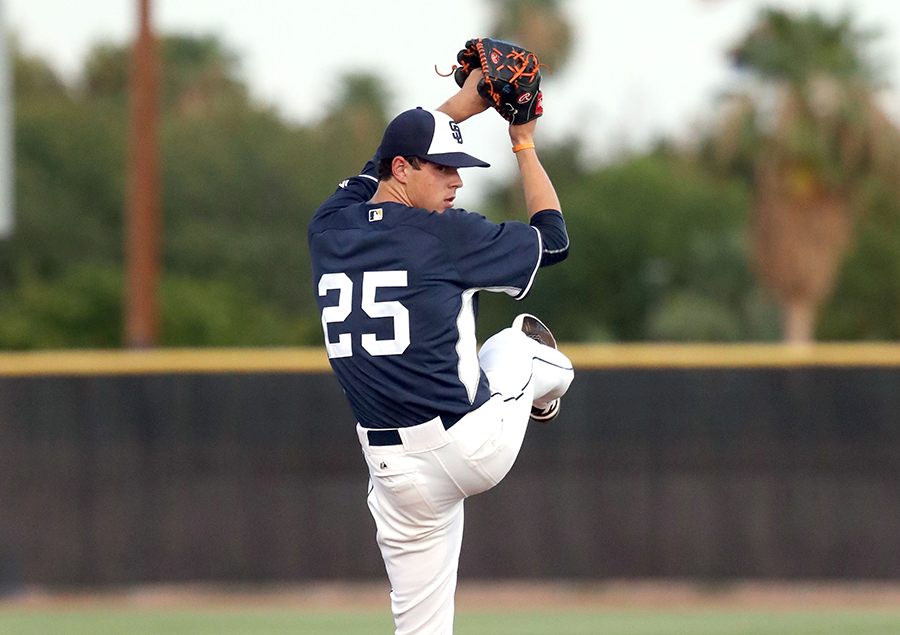
Credit: MiLB
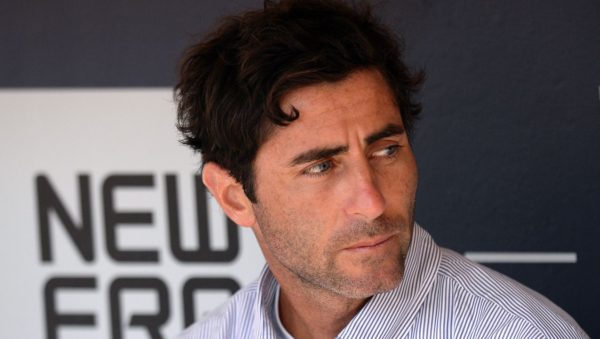
The San Diego Padres top 30 prospect list is out and here is an evaluation of each of the players.
The San Diego Padres have not had much success in recent memory. The team has not had a winning season since 2010 and has not made the playoffs since their NLDS loss to the St. Louis Cardinals in 2006. It has certainly not been an exciting decade for Padres fans across the world.
Times are changing, however, as general manager, A.J. Preller and the Padres are on the way up. San Diego nabbed the two biggest fish on the free agent market in the last two offseasons, Eric Hosmer and Manny Machado, and finally looks like a team that can compete for a championship.
The reason behind this? An absolutely loaded farm system with incredible talent scattered throughout all its’ minor league levels.
For the second straight year, I will be breaking down each of the Padres’ top 30 prospects according to MLB.com’s Pipeline. These evaluations will take into consideration the positives and negatives of each prospect, upside, estimated time of arrival to the major leagues, and some projections.
1. Fernando Tatis Jr., Shortstop
Depending on what your viewpoint is, there may not be a better prospect in all of baseball than Fernando Tatis Jr.
After breaking his thumb halfway through his first full season at the Double-A level, many envisioned that Tatis would start the season with the El Paso Chiuahahas, the Padres’ Triple-A affiliate. This all changed after a phenomenal performance in the Dominican Winter League, where the 20-year-old phenom led his hometown Estrellas Orientales team to a championship for the first time in 50 years. His performance over the winter, paired with a solid spring and the support of several big league teammates was enough for the prized prospect to find his way on the major league roster at the end of spring training.
There is certainly a lot to like about Tatis, both offensively and defensively. He has one of the higher offensive ceilings among minor league players in recent memory as Tatis hits for both average and power. The 20-year-old knows how to use all parts of the field, and there is a realistic shot that we see him put multiple seasons with a batting average above .280 and 30+ home runs. Once he reaches base, which he does quite a lot, Tatis is an immediate threat to swipe a bag with his instincts on the bases and his incredible speed. A few years ago scouts profiled him to have average speed, which simply is not true. He can run with the best of them and could be a true 30-30 threat when he is in his prime.
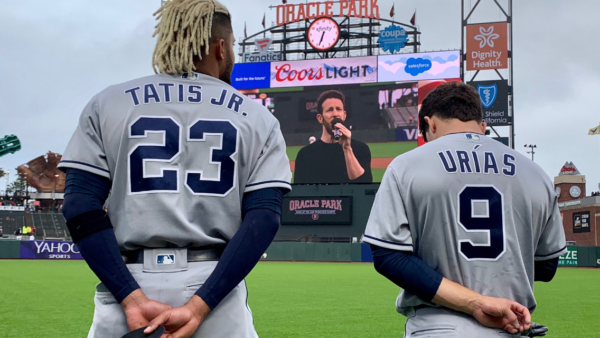
It is not a realistic thought that Tatis could also win a few gold gloves throughout his career. He possesses natural lateral range and his 6’3″ frame aids him in having a fantastic vertical range as well. His arm is more than suited to play shortstop, which is his best position long-term, and he just has a knack for making a play on any ball in his vicinity. The Padres may already have the best defensive duo in baseball with Machado and Tatis on the left side of their infield.
Several comparisons come to mind when thinking about Tatis and you can’t really go wrong with any of them. At his absolute worst, Tatis projects to be Andrelton Simmons with more power. If he reaches his true potential, which is very possible, then he is essentially Manny Machado. Regardless of what happens, it is safe to say that the Padres will not be disappointed with Fernando Tatis Jr. for years to come.
2. MacKenzie Gore, LHP
When the Padres selected MacKenzie Gore with the third pick in the 2017 MLB draft, many scouts and analysts believed that he would ultimately be the best player to come out of that draft class. This did not appear to be the case last season as Gore struggled mightily in his first full professional season and was plagued by blister injuries. The 20-year-old left-handed pitching prospect is entering the 2019 campaign fully healthy, as proven by his dominant performance in a scrimmage game against a Mexican league team a few weeks ago.
The most intriguing thing about Gore is the fact that he possesses four pitches with “plus” potential. This means that when he is fully developed, the Whiteville native could have four above-average major league pitches. His fastball tends to sit in the mid-90s, but Gore was recently touching 98 mph during his outing in Mexico. Gore’s go-to putaway pitch his curveball, which typically sits in the mid-70s and has a great vertical break to it. His power slider and a solid changeup round out arguably the most impressive arsenal in the minor leagues. Not only are all of his pitches tremendously advanced, but he also commands each pitch well and throws them for strikes at any point in the count. His 6-foot-3 frame is ideal for a major league starter, and his sneaky good athleticism allows him to repeat one of the funkiest deliveries in the minor leagues.
At his absolute worst, MacKenzie Gore is a back-end starter on a very good team. His upside, however, is a front-of-the-rotation starter with the potential to be an ace. There is a ton of things going for him, primarily his insane repertoire, that suggests he will have a very successful major league career. If all goes well for Gore, there is a possibility for him to compete for a rotation spot in 2020 with the Padres.
3. Luis Urias, Second Baseman
Prior to spring training starting this year, Luis Urias seemed to be one of the only players in camp with the Padres that had his spot secured. Urias was the odds-on favorite to start at shortstop on opening day until phenom Fernando Tatis Jr. was called up, which would then move Urias over to second base and bump veteran Ian Kinsler into a super utility role. Everything but that happened for the 21-year-old prospect as Tatis stole the show and Kinsler dominated spring training, while Urias struggled mightily with his approach at the plate.
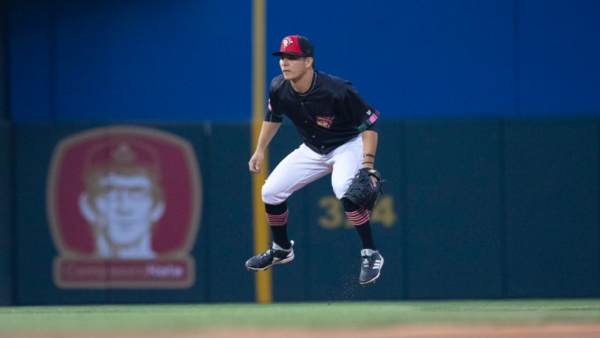
This demotion should not take anything away from Urias, however, as the Mexican native is still one of the more refined hitting prospects in all of baseball. His calling card has and always will be his ability to put solid contact on the baseball, which is what he struggled with mightily this spring. It appeared that Urias was trying to hit for more power this spring instead of just living in the gaps like he normally tends to do. His bat-to-ball skills are otherworldly, and he has the strike zone recognition of a veteran despite only being 21 years old. Urias does not tend to strikeout a lot, except for this spring where he struck out way too much, and just finds ways to get on base at an above-average clip. Defensively speaking, Urias is an above-average defender at second base that can also play shortstop fairly well. He has an above-average arm, has good range, and soft hands that allow him to play a quality defensive second base.
Urias might have the highest floor of any prospect in this system not named Fernando Tatis Jr., as his offensive and defensive skills will allow him to be an average major league player at least. One of the sneaky good player comparisons for Urias is his current teammate, Ian Kinsler, as Kinsler has a career batting average of .271 and gets on base at a .339 clip while playing gold glove caliber defense and being a solid leadoff hitter for the majority of his career.
4. Francisco Mejia, Catcher
The Padres acquired Fransisco Mejia a few weeks before the trade deadline last season in a deal that sent relief pitchers Brad Hand and Adam Cimber to the Cleveland Indians. Mejia, who was once the top catching prospect in all of baseball, is one of the more advanced offensive catching prospects in the last decade.
His 50-game hitting streak in 2016 was the longest such streak since 1963 and his career .293 batting average in the minors speaks to his offensive skills. The 23-year-old is a switch-hitter, which is unusual for a catcher. He has a knack for barreling up the baseball despite his short stature. His power comes from his quick hands, as Mejia can turn on any pitch and drive it into the gap with no problem. For a player playing a position that is not known for its offensive production, Mejia’s offensive skills are extremely impressive.
The biggest question marks surrounding Fransisco Mejia almost exclusively come from his defensive game. His arm has never been a concern, as several scouts and coaches have said that Mejia might have the best arm on a catcher that they have ever seen. The rocket that he has on his right arm allows him to control the running game, which is obviously an important part of being a catcher. Mejia’s receiving skills are the biggest question mark, as he does not currently have the traditional skills needed to be a solid pitch framer. He has improved in his department over the years, but Mejia needs to continue improving if he wants to be the catcher of the future for the Padres.
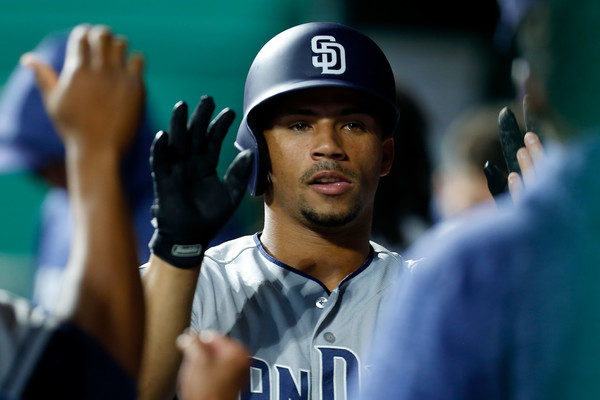
Mejia is one of the most talented prospects in this system, but he does need to improve certain aspects of his game if he wants to become a solid major league catcher. The Padres have been hesitant to package him in a trade and do not intend to move him from behind the plate because they believe he has what it takes to one day be that for them. Mejia’s bat is going to play at the big league level, which is why there is serious potential for him to one day be the best offensive catcher in baseball. The big thing to follow with him, however, will be if he can improve his skills defensively.
5. Chris Paddack, RHP
The arrival of Chris Paddack to San Diego this season provided a tremendous boost to a pitching staff that desperately needs it. Paddack was acquired from the Miami Marlins in a deal that sent former all-star closer Fernando Rodney to the Marlins in June of 2016. Shortly after his acquisition, Paddack suffered a forearm strain that required Tommy John surgery and would sideline him for the entire 2017 season. His return to the minor leagues in 2018 was one of the more incredible recovery stories in recent minor league memory.
Paddack dominated both the California League and Texas League last season. In only 90 innings pitched, the 23-year-old posted a 2.10 ERA with a 0.80 WHIP, 120 strikeouts, and only eight walks. His dominant 2018 campaign paired with an incredible spring training was enough to earn the former eighth-round pick a spot in the Padres’ 2019 rotation.
Paddack’s arsenal is essentially compromised of two pitches, with a third pitch in the making. His fastball usually sits in the 94-96 mph range and has a good run to it. He has an impeccable command of his fastball and can spot it anywhere in the zone at any point in time. His changeup is easily his best pitch, and might be one of the best pitches out of any prospect in the top 100, and is already an above-average big league pitch in the eyes of some scouts. It has a great dip to it and is noticeably slower than his fastball which aids in keeping the hitters off balance. Paddack’s third pitch, his curveball, is still in the developmental phase but has shown signs of life. He is going to have to be able to throw it for strikes early and often if he wants to be able to consistently maneuver through big league lineups. Paddack’s best attribute is his competitiveness and poise on the mound. Nothing phases this kid, and he has that “killer” instinct that not everybody has.
Paddack is right up there with any pitching prospect in all of baseball. He has dominant stuff and controls it effectively, giving him a devasting duo that will allow him to compete in any game he’s pitching in. If his curveball can become an average pitch than Paddack has front-line starter written all over him. His command and poise still give him the opportunity to be a third or fourth starter even if that curveball does not develop.
PAGE 2 LINK BELOW
Diego works at Prep Baseball Report as an Area Scout in Illinois and Missouri. He graduated this spring with a Bachelor Degree in Communications and played four years of college baseball, logging nearly 50 innings of work in a relief role. Diego hopes to work in an MLB front office one day and has been a Padres fan since he was six years old.
Does anyone know where espinosa is playing now, or any prognosis?
He is in Arizona presently… will be in Lake Elsinore in a few weeks if he continues to progress